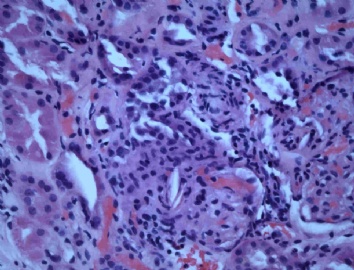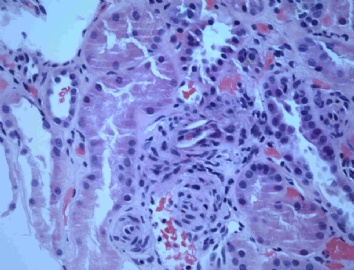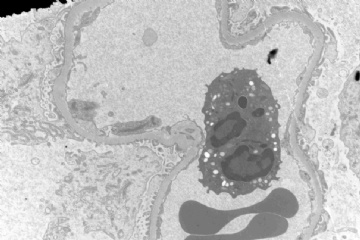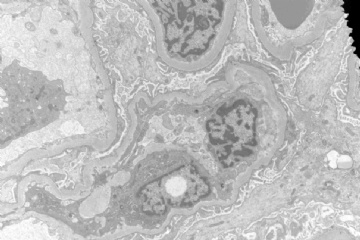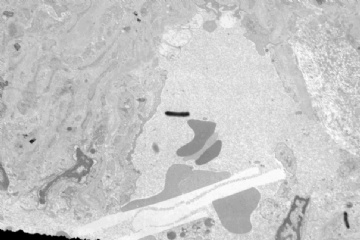| 图片: | |
|---|---|
| 名称: | |
| 描述: | |
- Kidney needle biopsy
-
本帖最后由 于 2009-06-30 20:39:00 编辑
似乎是系膜基质增多,伴中等度的电子致密物沉积;左下方深染的是什么呢?似乎是个核的切缘;
These photos were taken by a technician. I am not entirely sure that the capillary in this photo is (intra)glomerular capillary or interstitial capillary. I guess it is a capillary or arteriole close to glomerular vascular pole. Therefore, there is no well-defined mesangium. No electron dense deposits are identified, either. 左下方深染的是grid bar. The plastic sections are put on the grid to be examined under electron microscope. The grid is made of copper, Ni or gold.
Hi, 197, Here is your decription of the above EM photo:
超微图1:内皮细胞基膜局限性增厚,伴电子致密物沉积;小灶上皮细胞足突融合;毛细血管腔内分叶核细胞浸润?
内皮细胞基膜局限性增厚
The glomerular basement membrane (GBM) is not obviously thickened. Some segments of GBM appear thickened probably due to tangential section. There are two ways to judge the thickness of the GBM. 1) Using the average width of the foot process: the "normal" thickness of GBM should roughly equal to the average width of the foot process. 2) Doing the actual measurement of the GBM: today more and more electron microscopes are equipped with digital cameras. It is easy to measure the thickness of GBM on the computer. The problem is how to define the normal range of GBM thickness. There is no standard range. Based on my reading, 250 nm could be used as lower limit and 460 nm could be considered as upper limit.
伴电子致密物沉积
There are no electron dense deposits.
小灶上皮细胞足突融合
There is little foot process fusion or effacement. We could ignore it in this photo.
毛细血管腔内分叶核细胞浸润?
Yes, you are right!
| 以下是引用geng72在2009-6-18 10:34:00的发言:
很好的病例,第一次见到这样的病例。 有一点疑问的是:病人有急性肾功能衰竭,应该是绝大部分的肾小球都受累,这些胆固醇拴子来自那个血管呢?如果是来自主动脉等肾外的大血管,除了肾功能受损外,其它的脏器也应该受损,如脑、脾等,如果来自肾动脉,两个动脉同时发生胆固醇栓子的机会应该是比较少啊! |
Here is a recent reference which may answer the above questions:
Cholesterol crystal embolism: A recognizable cause of renal disease.
Division and Chair of Nephrology and Department and Chair of Pathology, Spedali Civili and University, Brescia, Italy. fscolar@tin.it
Cholesterol crystal embolism, sometimes separately designated atheroembolism, is an increasing and still underdiagnosed cause of renal dysfunction antemortem in elderly patients. Renal cholesterol crystal embolization, also known as atheroembolic renal disease, is caused by showers of cholesterol crystals from an atherosclerotic aorta that occlude small renal arteries. Although cholesterol crystal embolization can occur spontaneously, it is increasingly recognized as an iatrogenic complication from an invasive vascular procedure, such as manipulation of the aorta during angiography or vascular surgery, and after anticoagulant and fibrinolytic therapy. Cholesterol crystal embolism may give rise to different degrees of renal impairment. Some patients show only a moderate loss of renal function; in others, severe renal failure requiring dialysis ensues. An acute scenario with abrupt and sudden onset of renal failure may be observed. More frequently, a progressive loss of renal function occurs over weeks. A third clinical form of renal atheroemboli has been described, presenting as chronic, stable, and asymptomatic renal insufficiency. The renal outcome may be variable; some patients deteriorate or remain on dialysis, some improve, and some remain with chronic renal impairment. In addition to the kidneys, atheroembolization may involve the skin, gastrointestinal system, and central nervous system. Renal atheroembolic disease is a difficult and controversial diagnosis for the protean extrarenal manifestations of the disease. In the past, the diagnosis was often made postmortem. However, in the last decade, awareness of atheroembolic renal disease has improved, enabling us to make a correct premortem diagnosis in a number of patients. Correct diagnosis requires the clinician to be alert to the possibility. The typical patient is a white man aged older than 60 years with a baseline history of hypertension, smoking, and arterial disease. The presence of a classic triad characterized by a precipitating event, acute or subacute renal failure, and peripheral cholesterol crystal embolization strongly suggests the diagnosis. The confirmatory diagnosis can be made by means of biopsy of the target organs, including kidneys, skin, and the gastrointestinal system. Thus, Cinderella and her shoe now can be well matched during life. Patients with renal atheroemboli have a dismal outlook. A specific treatment is lacking. However, it is an important diagnosis to make because it may save the patient from inappropriate treatment. Finally, recent data suggest that an aggressive therapeutic approach with patient-tailored supportive measures may be associated with a favorable clinical outcome.
|
有一点疑问的是:病人有急性肾功能衰竭,应该是绝大部分的肾小球都受累,这些胆固醇拴子来自那个血管呢?如果是来自主动脉等肾外的大血管,除了肾功能受损外,其它的脏器也应该受损,如脑、脾等,如果来自肾动脉,两个动脉同时发生胆固醇栓子的机会应该是比较少啊! These are good questions. Though this case is not my first one, I have not thought about these issues. I need do some reading and then answer these questions. |
-
In this biopsy, the most striking change is the empty, needle-like clefts within the arterioles (photo 1, 2, 3, 5) and occasionally in capillaries (photo 4, 8). We may see multinucleated giant cell engulfing the clefts (photo 5). This is cholesterol embolism induced acute renal failure.
Photo 3 shows a globally sclerotic glomerulus with a cleft at the presumed arteriole (vascular pole). The cholesterol embolus is probably responsible for the death of that glomerulus. But it most likely occurred a while ago, not several weeks ago. I think this patient must have severe atherosclerosis at the aorta which ruptured and released the contents of atheroma to blood flow. The surgical event (endovascular grafting) made the situation worse, at least temporally.
The last EM photo demonstrates subendothelial space widening. I interpret it as acute ischemic change. This type of change is also seen in thrombotic microangiopathy or transplant glomerulopathy. In this biopsy, it is focal and not severe enough. The thrombotic microangiopathy also does not fit the clinical picture.
